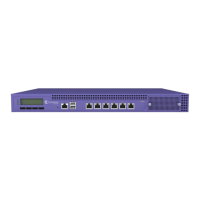Table 40: Neighbor Recovery Settings
Field Description
Power Hold Time (seconds) The number of seconds Smart RF waits before changing radio
channels in response to channel noise. This hold timer definition avoids
channel flapping. Range is 0 to 3600 seconds.
Neighbor Recovery
2.4 GHz Neighbor Power Threshold
(dBm)
Defines the maximum power the 2.4 GHz radio will emit to
compensate for a failed neighbor radio. Valid values are -85 to -55
dBm. Default value is -65 dBm.
5 GHz Neighbor Power Threshold (dBm) Defines the maximum power the 5GHz radio will emit to compensate
for a failed neighbor radio. Valid values are -85 to -55 dBm. Default
value is -65 dBm.
Dynamic Sample Recovery
Dynamic Sample Enabled Enables an administrator to define how Smart RF adjustments are
triggered by locking retry and threshold values.
Dynamic Sample Retries (1-10) Define the number of Dynamic Sample Retries.
Dynamic Sample Threshold (1-30) Define the Dynamic Sample Threshold.
Related Links
Basic RF Management Settings on page 87
Channel and Power Settings on page 88
Scan Settings for Smart RF on page 92
Interference Recovery Settings for Smart RF on page 94
Interference Recovery Settings for Smart RF
The following settings define thresholds for the Smart RF policy Interference Recovery plan supported
on ExtremeWireless WiNG APs and AP5xx The default Smart RF policy enables Interference Recovery.
Note
Before you can edit these parameters, select Custom Sensitivity from the Basic Smart RF
configuration tab.
Click Recovery > Interference Recovery and configure the following parameters.
Table 41: Smart RF Interference Recovery Settings
Field Description
Noise When enabled, Smart RF policy scans for excess noise from wireless
devices. When noise is detected, Smart RF-supported devices can
move to a cleaner channel. Decision to move is based on Noise Factor
setting. This feature is enabled in the default Smart RF policy.
Noise Factor Define the level of network interference the Smart RF policy considers
when calculating interference recovery. The default setting is 1.50. The
range is 1.0 to 3.0.
Configure
ExtremeCloud Appliance User Guide for version 4.36.03 94

